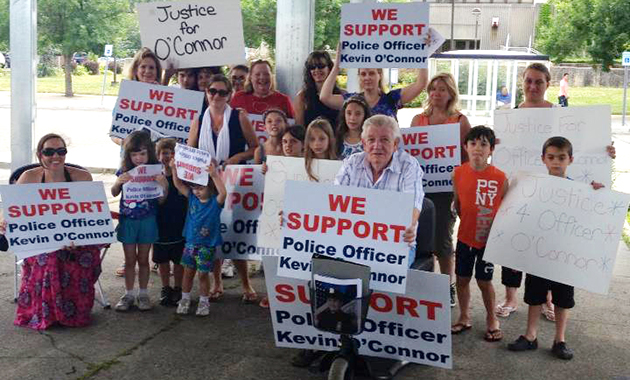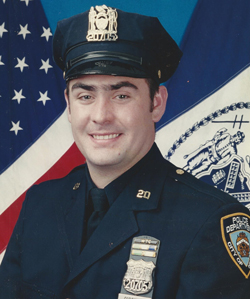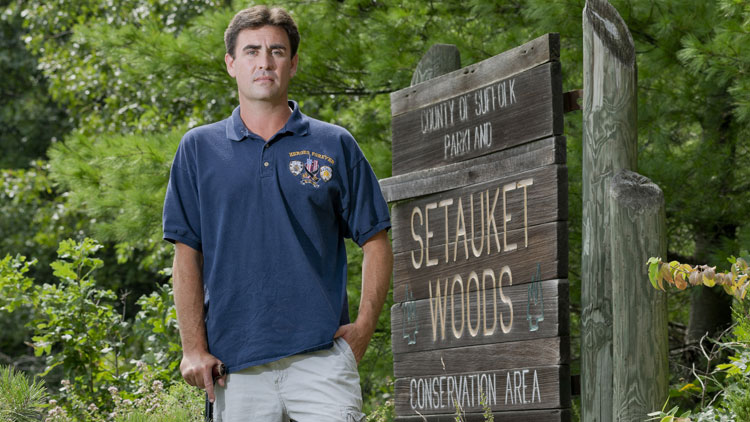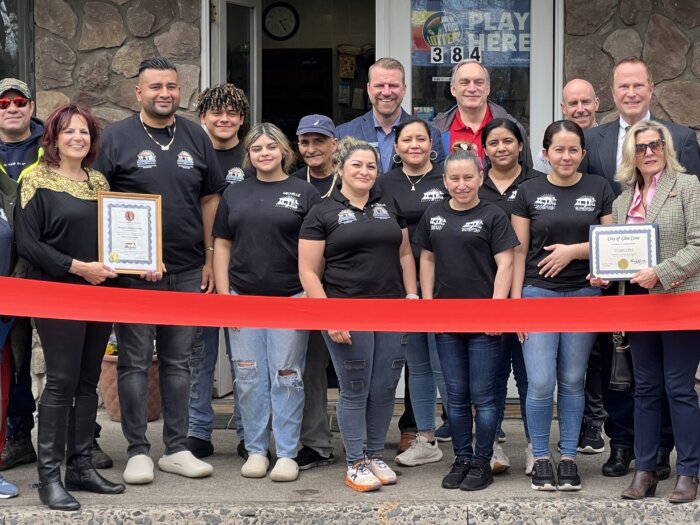Kevin O’Connor leans forward and grimaces as the pain shoots through his body.
His chair slides back, he reaches for his cane and slowly rises from his seat.
“I just gotta stand up,” he tells me.
His wife Catherine gazes at him from across the kitchen table while their kids play in another room.
We could stop, but O’Connor wants to keep talking. He’s been waiting seven years to tell this tale—nearly a decade of doctor visits, surgery, therapy, court appearances and haunting images of being struck by a teenager illegally riding an ATV, which left the former New York Police Department cop and Suffolk County Park police officer disabled for the rest of his life.
He needs a cane to walk short distances. His feet turn pale blue if he stands for too long. And the 37-year-old father of four is relegated to a wheel chair or scooter whenever he leaves his home.
O’Connor lists his many ailments in a matter-of-fact tone: a shattered left ankle rebuilt with a bone from his hip, fractured right kneecap, torn meniscus, nerve damage in his back and left leg too serious for surgery and a condition called “Complex Regional Pain Syndrome,” which leads to chronic pain and negatively effects blood flow and body temperature to the point that all sensations but pain are suppressed.
At his worst, O’Connor was taking more than 30 different pills—a cocktail of pain and nerve medication. (His pancreas, liver and gall bladder all shut down because of it). He slept 23 hours a day, Catherine says, and couldn’t even finish his own sentences. His sensory was so out of whack that he couldn’t tell where he was being touched. Not knowing what was happening to him was almost unbearable; terror consumed him whenever Catherine would leave his side—even for the briefest of moments.
“All you feel is pain all the time,” he says.
Yet those are just the injuries sustained from being plowed into by an ATV.
O’Connor, who joined the NYPD in 1998 and worked at Ground Zero following the Sept. 11, 2001 attacks, had all eight sinuses collapse and later had three tumors removed—two of which were attached to his optic nerve. He also had dozens of polyps extracted.
“The surgeon said at 30 he stopped counting,” he recalls.
After 9/11, O’Connor’s family persuaded the gung-ho cop to leave the NYPD—fearing future terrorist attacks—and he joined the Suffolk County Park Police Department in 2003. The family assumed he’d be safer patrolling the vast parks stretching from Wading River to Orient Point and Montauk.
Who would have guessed it’d be in the typically tranquil forests of Suffolk where he’d encounter his most vicious assailant.
His pain doesn’t end with his physical injuries. O’Connor still seeks justice all these years later because of unanswered questions stemming from the Suffolk County police investigation into the incident, and frustration over the outcome of his attackers’ prosecution after an appeals court overturned a guilty verdict rendered by Suffolk County Family Court.
That acquittal is even more heart-wrenching because O’Connor’s attacker actually confessed to striking him in a civil case—as did his parents admit to negligently allowing their child to use the ATV that injured him. (The Press has decided to withhold O’Connor’s attacker’s name from publication due to his status as a minor at the time of the incident.)
Dozens of documents obtained by the Press, including police and court records, along with witness statements, paint a portrait of an officer who was assaulted while on the job and who’s had to endure great pains for the past seven years to get justice for that attack. They tell how it took fellow police officers five days to interview his assailant’s parents and two neighbors—five days after the accident—despite O’Connor charging that a Suffolk police detective tracked down the suspect’s father several hours after he was struck, and despite initially describing the incident, say internal police records, as assault on a parks police officer. That’s a charge that would regularly constitute a maximum sentence of three to four years in prison if found guilty. Yet the charges were later dropped to a misdemeanor offense of leaving the scene of an ATV accident.
Instead of justice, the voluminous paper trail reveals the disabled police officer and 9/11 first responder’s pay was docked. He became ensnared in a drawn-out dispute over his disability and retirement classification.
“They want me to quit,” he blasts. “They just want me to quit, to go away and not get paid and not have benefits and just quit. I have four children, my wife; we have to live.”
O’Connor’s leg is elevated on an ottoman while describing the last seven years of agony. His eyes are glassy; the horrors of his accident seared into his mind forever.
APRIL FOOL’S DAY
Suffolk County Park police officer Kevin O’Connor woke up to the sounds of rain against his house April 1, 2006. At 31 years old, O’Connor was comfortable with his decision to leave the prestigious NYPD. He just wanted to strap on a badge and catch bad guys.
“The only way for evil to prevail is for good men to do nothing,” is the motto he’s always lived by, he says.
On that day—“April Fool’s Day,” he says with a nervous laugh—O’Connor donned his police uniform and met up with his 39-year-old partner. The pair grabbed a stack of complaints before they left the station and hopped into a truck hauling a trailer with ATVs inside.
Their plan for the day was simple enough: Patrol the Setauket Woods Nature Preserve and investigate recent complaints of illegal ATVs running rampant in the area.
They put the truck in park and unloaded the ATVs from the trailer. Puddles began to form beneath their feet.
They drove deep into the preserve, mud kicking off the tires as they accelerated.
At about 1:45 p.m., the officers spotted a 25-year-old man riding a dirt bike east of North Belle Mead Road, near the Long Island Power Authority power lines. While issuing a summons to the biker, they became distracted by the sudden, ripping of jackhammer-like sounds thundering through the woods.
Within an instant, three ATVs shot from the leafy trees and barreled toward them from the south.
The three riders—outfitted in different color helmets, chest protectors and quads (the color of their outfits and ATVs would become an important piece of evidence in the appeal’s court case)—finally emerged from the woods.
O’Connor’s partner was the first to react. Perched atop his quad, he drove about 40 yards in the direction of the trio. Two bolted past him on the west side and continued north, forcing him to give chase.
“We attempted to flag them down and stop them as they came upon us but they disregarded our demands and took off,” O’Connor’s partner told Suffolk County police six hours later in his written statement.
O’Connor, still on foot, spotted the third ATV in the distance and waved his hands over his head, commanding the driver to stop. His warnings went unheeded. In a last-ditch effort to avoid the oncoming machine, O’Connor lunged right, but it turned in his direction and crushed him, he told police, from Stony Brook University Hospital that night.
The ATV struck him with such force that O’Connor flipped over its handlebars and was launched into the air. Managing to grab hold of the teen’s clothes, he was dragged for about 10 feet before letting go.
With the same lightning-fast speed they’d appeared, all three ATVs then disappeared into the woods.
The dirt bike rider O’Connor had been giving a ticket to witnessed the crash and ran to O’Connor’s aid.
“I asked the police officer if he was okay,” the man told police eight hours later, according to documents. “And he replied ‘No.’”
O’Connor’s partner, unaware of what had happened to him, had already lost the first two ATVs and was returning to O’Connor’s location when he spotted the third, yellow quad. He cut into a wooded trail off of Belle Mead Road.
“This rider appeared to be well acquainted with the trails in the area as he pulled further away from me during this chase,” he told investigators.
The officer followed the trail to a development under construction at the time, he said. The yellow ATV disappeared.
The initial response to the incident was impressive: Suffolk County police, New York State police, New York State Department of Environmental Conservation (DEC) police and Suffolk County Park police all responded, O’Connor says.
After all, one of their own was attacked and injured.
He assumed the case a slam dunk: There was an actual witness to the incident and he later discovered that an environmental conservation officer followed the ATV tracks to a house just west of the preserve and notified Suffolk police after he spotted three ATVs—blue, black and a “freshly washed” yellow quad—in the garage, he tells me. (The DEC officer, who no longer works on Long Island, declined to comment for this story).
Then things got murky.
The initial police report makes no mention of police visiting the teen’s house that day, but instead notes the investigators interviewed its residents and two neighbors five days later. They “all stated that there are a lot of people who ride quads in the area,” but did not see any ATV activity the day of the incident, states police documents.
The report doesn’t note if the teen was a suspect, either. So the investigation, initially being investigated as “assault 2 on parks police officer,” stalled.
“Due to the fact that there are no further leads at this time,” the report said, “this case may be marked as pending.”

CONFESSION
Eight months later, it seemed the O’Connor’s might have finally caught a break.
Police had impounded a blue 2004 Yamaha in the Setauket Woods preserve around 1 p.m. on Dec.3, 2006 and the driver, who was 15 at the time, provided information to the officer regarding an incident involving Suffolk County Park police officer O’Connor.
One month later, at around 5 p.m. on Jan. 2, 2007, a Suffolk police detective visited the house of another Setauket teenager and left with a sworn statement from the 15-year-old admitting to driving one of the three ATVs the day O’Connor was injured. Obtained by the Press, it states the teen told the detective that he and another friend separated from the driver of the yellow ATV, and that it wasn’t until they crossed paths in the hallway of their high school two days later that they’d learn what had actually happened.
“I hit someone with the quad,” the teen admitted to the friend.
Still, there was no arrest.
Meanwhile, O’Connor and his wife called Suffolk Police Department’s Sixth Precinct multiple times, along with Suffolk County legislators.
Presiding Officer William Lindsay (D-Holbrook) asked then-Suffolk County Park Commissioner Ron Foley to address the status of the case at a meeting that year.
“We have asked questions of the Suffolk County Police Department about this case,” Foley told legislators, according to the meeting’s minutes. “I am satisfied that they were dealing with it in the same professional manner they deal with everything they do.”
Yet quite the opposite was happening, insists O’Connor, who stepped up calls to elected officials for help.
He called and wrote letters to then-Suffolk County Executive Steve Levy, former Suffolk County Police Commissioner Richard Dormer, state legislators, then-Sen. Hillary Clinton, the governor, and even Vice President Dick Cheney.
“Nobody was doing anything,” he says.
O’Connor, who went back on light duty for two months after the incident but was deemed too unhealthy to work, was battling debilitating injuries as a result from the crash and was in excruciating pain. He would sleep for nearly the entire day and the nerve damage was so painful that the slightest touch whipped his body into a frenzy.
Finally, nearly a year later, authorities filed formal charges against the teenager—but not for felony assault, which would’ve landed him before a criminal court judge. Instead, the teen was charged with leaving the scene of an accident involving an all-terrain vehicle—a slap on the wrist is the way the O’Connor’s felt about it at the time.
(Suffolk police did not respond to requests for comment as of press time. Instead, they said, they were handling the Press’ submitted inquiries as a Freedom of Information Act request).
The teen was found guilty in a one-day Family Court hearing and placed on 12 months probation, despite the mother’s alibi testimony that her child was with her at her sister’s house when the incident occurred.
It was a brief victory for the O’Connors.
The next summer, an appeals court overturned the decision on “legally insufficient evidence.” Two of the witnesses “could not specifically recall riding that day,” according to the decision, even though one teenager admitted in a sworn police statement to being in Setauket Woods that afternoon.
The court cited three other reasons for overruling the Family Court decision: that O’Connor and his partner couldn’t identify the rider of the yellow ATV; the two officers had identified the two other quads as black and blue, while the witnesses—the teen’s friends—said they were riding red and white ATVs; and that the yellow ATV was outfitted with knobbed or “holeshot” tires, not the “grooved” tires that O’Connor testified to.
It was a crushing blow, especially since the O’Connors felt the teenager’s family had already admitted guilt—though not in a court of law.
Even before the appeals court made its decision, the teen’s family filed an insurance claim for an ATV, noting that it was damaged on April 1, 2006—the day O’Connor was injured. The claim was denied.
The O’Connors eventually got a full confession—though five years too late.
“This confession of judgment is for the debt justly due arising from the following facts,” reads the admission in the civil case. “On April 1, 2006 at Setauket Woods Park in Suffolk County, New York, the debtors…negligently entrusted an All Terrain Vehicle (‘ATV’) to their son…[who] negligently drove this ATV and struck pedestrian Kevin O’Connor, causing serious physical injury.”
The O’Connors were awarded $1 million, plus interest, but they have yet to see any of it. The teen’s family filed for bankruptcy soon after.
The family did not return a message seeking comment.
To make matters even worse, during this time O’Connor had visited a doctor for an Independent Medical Exam (IME), which the state requires prior to certifying an employee for disability retirement—and the doctor noted that O’Connor “has a permanent marked orthopedic disability and is unable to return to work as a park police officer.”
About a month later, he received a letter from his lieutenant, Scott Gray, instructing him to notify the personnel office proof that he has filed for disability retirement with the New York State Retirement System within 10 days.
“Your failure to adhere to this directive will be considered insubordination and will be dealt with accordingly,” the letter states.
After making phone calls to the retirement system, O’Connor says he made the grim discovery that he was a member of the Employees Retirement System, meaning he would not be afforded the same benefits had he remained with the NYPD—which is under the Police & Fire Retirement System.
Thus began a new chapter in O’Connor’s nightmare since the ATV accident.
Because of the confusion with the retirement system, O’Connor hadn’t filed the proper paperwork as instructed by Gray, but he was in the process of trying to get it all sorted out, he says.
In November 2011, O’Connor was brought up on administrative misconduct charges for failing to submit proof of having filed for disability retirement with the state. The letter was signed by then-Deputy Commissioner of Parks, Recreation and Conservation Tracey Bellone—the wife of Suffolk County Executive Steve Bellone.
An additional misconduct charge read: “On July 29, 2011, you exhibited conduct and behavior unbecoming of a parks police officer when you were insubordinate and refused to comply with a lawful directive.”
“Clearly they knew Kevin was looking into retirement,” adds his wife Catherine.
BLAME GAME

The county is sticking to their guns.
“The problem with Mr. O’Connor is that Mr. O’Connor thinks that he is supposed to be in a different system than he really is in and that’s what the issue is,” Acting Director of Labor Relations Jennifer McNamara tells the Press. “It’s the crux of the problem and he continues to think that this is a county issue but it’s actually not, it’s the state that makes the determination as to what retirement system someone’s in when they begin their employment, which for Mr. O’Connor is many years ago. He never challenged it then. But now that it’s time for him to retire into a system he refuses to go into the one that he’s in.”
“He has no right to be in the Police and Fire system,” she insists. “If that’s the fight that he wants to have, it’s not with the county. Unfortunately, there’s nothing we can do about that.”
The New York State Comptroller’s office, which oversees the state retirement system, declined to speak on the record regarding O’Connor’s situation.
The only way O’Connor would be able to change retirement systems is through state legislation, officials said. He cannot opt-in himself.
A spokesman for a state official, who asked not to be named, said it’s unlikely that the state would step in. When they do, like they did this past year with a Quogue Village police officer, it’s usually to correct a “technicality,” he said.
“Essentially what he is saying is ‘I left one system, I became a police officer in another system, I got injured on the job, but my benefits aren’t so good here, I should have the old system,’” the spokesman said. “Well, no.”
“This is not clear-cut by any stretch of the imagination,” he added.
O’Connor also has other gripes with the county.
The family came home from vacation in July 2012 and noticed “weird checks” in the mail for $400. After looking further into it, O’Connor also discovered that he was missing money from his bank account. Apparently, the county had stopped paying him because he failed to comply with the directive to file his disability retirement papers.
After filing a grievance, the county reimbursed him for docked salary June 11, 2012 to Aug. 19, 2012, a total of 50 workdays.
There’s also the issue of three IMEs the county says O’Connor recently skipped, which he’s mandated to attend pursuant to his contract, resulting in a 30-day suspension earlier this year, according to the county. The state, officials said, only allows those seeking disability retirement to miss two at the most.
“There is no excuse. He is disabled,” McNamara says. “Both his contract and the New York State Retirement System require that you go to this exam if you want to be retired. He has not gone for three times despite being directed to do so.”
O’Connor contends that he’s been to more IMEs than he can count, adding that he contacted the Deputy Sheriffs Union Police Benevolent Association (Suffolk Park police recently left that union for the Suffolk County PBA) to see if he had to go to the most recent exams and told him they’d look into it. They never called back, he says.
The Deputy Sheriffs PBA and Suffolk County PBA both didn’t return messages from the Press left for their respective presidents for this story.
O’Connor alleges that a private attorney representing the county actually admitted to him during negotiations that O’Connor is in danger of being fired.
“There are often things that are said in the litigation posture that are just that—they’re said, as part of litigation strategy,” McNamara says in response.
“We are still hopeful that we will be able to work this out in some way that is favorable to everyone,” she adds. “With as little animosity as possible and that everyone will get what they should get out of this.”
SMALL STEPS
O’Connor has a noticeable limp as he walks through his house.
He’s wearing a blue polo shirt emblazoned with the words “Heroes Forever” above a stitching of the Twin Towers wrapped in an American flag.
The conversation turns to his career cut short in law enforcement.
“I always wanted to be a cop,” O’Connor says. “I did everything I could to join the police force.”
And that included terrorist and undercover operations training. “Any training that came up, I took,” he says with pride.
He carried over that determination to Suffolk County Park police when he came over from the city, he says.
O’Connor remembers arresting a group of Latin Kings, an international street gang, who were having a meeting in the middle of a Suffolk County preserve one evening. He recalls the time he arrested a man who, as it turned out, was responsible for 30 burglarizes. The burglar followed illegal ATV riders home, then hotwired and stole them in the dead of night.
“It’s still a police job,” he says of the Suffolk County Park Police Department.
“I always said if he wasn’t going to be a cop he’d be a fireman and run into burning buildings,” Catherine adds.
Even if he can no longer hop in a police cruiser or ATV to chase down a perpetrator, O’Connor says he’s still committed to doing the right thing.
“Doing nothing,” he says, “is doing something.”
He just hopes someone would do the same for him and his family.


























